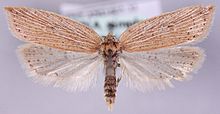
Acleris forsskaleana, the maple leaftier moth, is a moth of the family Tortricidae. It is found in Europe and North America in woodlands and gardens.

Acleris sparsana is a moth of the family Tortricidae found in Europe and Iran. It was first described in 1775 by the Austrian lepidopterists Michael Denis and Ignaz Schiffermüller.
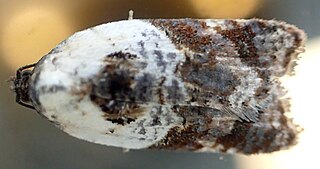
Acleris variegana, the garden rose tortricid moth or fruit tortricid, is a moth of the family Tortricidae. It has a Palearctic distribution. The moth flies from July to September mainly at night and is attracted to bright lights. The larvae feed on various trees and shrubs including rose and apple.

Acleris rhombana, the rhomboid tortrix, is a moth of the family Tortricidae. It is found in the Palearctic realm, from Europe to the Caucasus, Armenia, and Turkmenistan.

Acleris hyemana is a moth of the family Tortricidae. It is found in Europe.
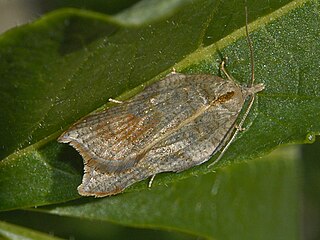
Acleris emargana, the notched-winged tortricid, is a moth of the family Tortricidae. The species was first described by Johan Christian Fabricius in 1775.

Acleris hastiana is a moth of the family Tortricidae. It is found in Europe, northern Iran, Kazakhstan, Ala Tau, central Siberia, Irkutsk, the Amur region and China. In North America it is found from the north-eastern United States across southern Canada to British Columbia and south along the Pacific Coast to California.

Acleris holmiana, the golden leafroller moth, is a moth of the family Tortricidae. It is found in most of Europe and Asia Minor.

Acleris ferrugana is a species of moth of the family Tortricidae. It is found in China, most of Europe and has also been recorded from North America.

Acleris schalleriana, the viburnum button or Schaller's acleris moth, is a moth of the family Tortricidae. It was described by Carl Linnaeus in 1761. It is found in most of Europe. It is also found in North America. Acleris viburnana is a possible synonym that refers to the North American populations.
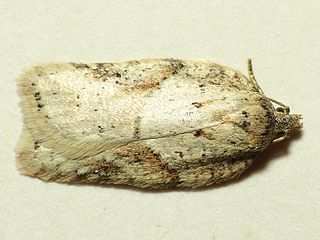
Acleris logiana, the black-headed birch leaffolder moth or grey birch button, is a moth of the family Tortricidae. It was described by Carl Alexander Clerck in 1759. It is found in most of Europe, except Ireland, Portugal, most of the Balkan Peninsula and Ukraine. It is also found in North America, the Russian Far East, Korea and Japan.
Acleris napaea is a species of moth of the family Tortricidae. It is found from Iran, Pakistan and Afghanistan eastward to Uzbekistan, Armenia and Turkmenistan. It is also found in Southeast Europe.

Acleris quercinana is a species of moth of the family Tortricidae. It was described by Zeller in 1849. It is found in most of Europe, Asia Minor and Iran.

Acleris abietana, the Perth button, is a species of moth of the family Tortricidae. It is found in Europe, where it has been recorded from Great Britain, Ireland, France, Belgium, the Netherlands, Germany, Denmark, Austria, Switzerland, Italy, the Czech Republic, Slovakia, Slovenia, Poland, Hungary and Russia. The habitat consists of coniferous woodlands.

Acleris fimbriana, the yellow tortrix moth, is a species of moth of the family Tortricidae. It is found in France, Germany, Denmark, Italy, Slovakia, Hungary, Romania, Poland, Norway, Sweden, Finland, the Baltic region, Ukraine and Russia. It is also found in China and South Korea.

Acleris lacordairana is a species of moth of the family Tortricidae. It is found in Germany, Austria, Switzerland, Italy, Hungary, Poland, Estonia, Latvia and Russia. In the east, the range extends to Japan.

Acleris lipsiana is a species of moth of the family Tortricidae. It is found in Great Britain, Spain, France, Belgium, the Netherlands, Germany, Denmark, Austria, Switzerland, Italy, the Czech Republic, Slovakia, Hungary, Poland, Greece, Norway, Sweden, Finland, the Baltic region and Russia. It is also found in North America, where it has been recorded from Alberta and Washington. The habitat consists of high moors and mountainous areas.
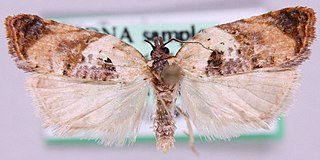
Acleris permutana is a species of moth of the family Tortricidae. It is found in Ireland, Great Britain, Portugal, Spain, France, Belgium, the Netherlands, Germany, Denmark, Sweden, Austria, Italy, the Czech Republic, Slovakia, Slovenia, Croatia, Hungary, Romania, North Macedonia and Russia. The habitat consists of coastal sandhills and limestone.

Acleris shepherdana, the meadow-sweet button, is a species of moth of the family Tortricidae. It is found in Europe, where it has been recorded from Great Britain, France, the Benelux, Germany, Denmark, Austria, Switzerland, Italy, the Czech Republic, Slovakia, Poland, Hungary, Norway, Sweden, Finland, the Baltic region and European Russia. It is also found in the Russian Far East (Ussuri), Manchuria, Mongolia, China and Japan. The habitat consists of fens, marshes, river-banks and other damp areas.

Acleris umbrana is a species of moth of the family Tortricidae. It is found in Great Britain, France, Belgium, Germany, Austria, Switzerland, Italy, the Czech Republic, Slovakia, Poland, Hungary, Norway, Sweden, Finland, the Baltic region and Russia. In the east, the range extends to Japan. The habitat consists of woodland, fens and marshes.
